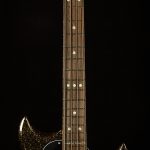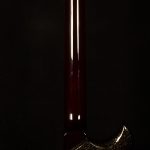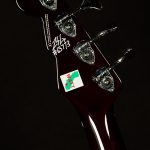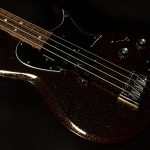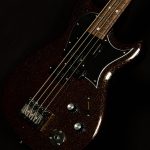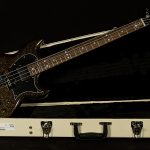Reverend Mike Watt Signature Wattplower Mark II Bass w/Case
Master of the Thud Staff
I think Mike Watt is the greatest bass player ever to lay finger to string, but I might be a little bit biased, because he’s the reason I started working the bass in the first place. I’ll never forget it: I was twelve or so, and I was watching Natas Kaupas’s part in the Santa Cruz Skateboards video Streets of Fire. Natas did this ridiculous move where he spun around on top of a fire hydrant, then this aggressive, jangly guitar part assaulted my ears.
After a few bars, this angular, funky bass line thumped its way through my speakers, and it was the coolest thing I’d ever heard. Later, I’d learn it was Mike Watt’s bass line that piqued my interest, and that the tune was “Brave Captain” by fIREHOSE, but my fate was already sealed. I begged my parents for a bass for Christmas and ditched the six-string for the thud staff.
The Legend of Watt from Pedro
I’m sure many other bassists have similar stories, because Mike Watt has had a profound impact on indie rock music over the course of his storied four-decade career. He got his start in the seminal punk rock band The Minutemen, where he and bandmates D. Boon and George Hurley blended frenetic funk with the energy of hardcore while sprinkling in a heavy dose of jazz harmonies, and art-house weirdness. The Minutemen were also quite influential in developing the philosophy of punk rock with their D.I.Y. spirit, relentless work ethic, and nuanced, principled political worldview.
After the tragic death of guitarist D. Boon, Watt almost quit playing music entirely. Luckily for music fans, Watt got a letter from a super fan named Ed from Ohio. Ed begged Watt not to quit, and even said he’d come out to California to jam. They formed a band called fIREHOSE, and they achieved a good deal of major label success in the nineties.
After fIREHOSE disbanded, Watt became one of the busiest dudes in indie rock. He put out three incredible rock operas, joined legendary garage punkers The Stooges for their reunion tours, and played on approximately 460,000 cool records. I’m only exaggerating slightly, by the way. Check his discography: he’s worked with everyone from Dave Grohl to Kelly Clarkson to Cedric Bixler-Zavala.
He still tours like a madman, too. I saw him at the Lion’s Lair with his Secondmen trio in Denver last winter and it was one of the most awe-inspiring performances I’ve ever seen. He played with the chops of a virtuoso and the energy of a nuclear bomb, even though he had just turned sixty the week before. It was one of the most inspirational live performances I’ve ever witnessed.
Wattplower Power
So, it is Wildwood’s profound honor to showcase the signature bass of such a legendary musician. And what an incredible bass it is! The Reverend Mike Watt Signature Wattplower Mark II bass is one of the coolest instruments we’ve ever had in our shop, because it feels, sounds, and looks like nothing else out there. So, let’s take a closer look and see what makes it so special!
Before we get into the specs of the instrument, we have to talk about how much careful consideration and elbow grease went into the development of this instrument. After Reverend first approached Mike about putting out a signature model, it took them FOUR YEARS of back-and-forth to get every detail exactly right. You can feel and hear every minute of this arduous R&D process the second you pick up this bass.
The power of the Wattplower Mark II is evident the moment you plug it in, and its singular voice is the result of three main features: its korina body, its P-Blade pickup, and its short-scale neck.
Good-Sounding Wood
Let’s start with the tonewood. Korina sounds similar to mahogany, but it has a livelier top-end and a bit more midrange bite to go with its round, warm low-end. This focused-yet-woody tone is GREAT for bass guitar, because it sounds deep enough to provide a rock-solid foundation for the band and punch enough to cut through the mix.
Draw Your Blade
The P-Blade pickup is a great match for the sound of korina, because it captures the classic thump and punch of a great old split-coil pup, but with extended low-end response, beefier mids, meatier trebles, and more volume overall. This powerful, throaty tone receives a dose of woody warmth from the korina body, resulting in a muscular, punchy tone that never approaches harshness despite its power.
The Wattplower Mark II ups the ante by adding in another half of a P-Blade and a Thumpbucker in the neck position. While this configuration may seem a little odd, it's actually quite intuitive to use. Putting the bass in the "bridge" position gives you the two P-Blades closest to the bridge, which makes the low-end a bit tighter. The middle position deactivates the pickup closest to the bridge and activates the P-blade closest to the neck, which gives the low-end more booming power. Finally, the neck position activates the Thumpbucker, which has an awesome vintage bass 'bucker vibe with vocal midrange along with warm, woody low-end and righteously smooth, fat highs.
Short on Scale, Long on Tone
Finally, the short-scale neck adds a whole bunch of extra special sauce to the sonic recipe. Short-scale basses have less string tension, which results in a more percussive, articulate attack and more bass boom. The strings also bend a little bit easier, allowing for the expressive vibrato that has been one of Mike Watt’s signatures throughout his career. In other words, the short scale-length lends a few pleasing upright-like qualities to the sound, and it makes for a supremely dynamic playing experience.
Let Your Fingers Fly
Speaking of the neck, holy cow is this bass ever fun to play! You can really feel the hours of R&D that went into this neck profile, because it is one of the fastest, most comfortable necks ever to grace a thud staff. Though it’s hefty enough that bassists used to a 34.5” scale won’t feel out of place, it’s slender enough for guitar players to feel right at home. Either way, you’ll have a hard time keeping a grin off your face as you fly up and down the fretboard!
Jamming Econo
Of course, the Wattplower also comes with all of the quality components we expect from a Reverend along with a few high-end surprises. It has a high-mass Hipshot A-style bridge for extra sustain, and Hipshot Ultralight tuners made of aircraft-grade aluminum for better neck-to-body balance. It also has a custom steel jack plate for extra durability, and Luminlay side dots that improve visibility on dark stages. Couple that with boutique-quality pots and caps, and you’ve got the sort of dependable workhorse bass that can handle gig after gig.
Impossible to Put Down
Wildwoodians, we are so excited to showcase the Wattplower for our exceptional customers. We know that its powerful sound, incredible playability, and top-notch build quality will provide you with endless hours of joy and inspiration. We invite you to pick up a Wattplower and experience the magic of these delightful machines. Once you do, we doubt you’ll be able to put it down.
Specifications:
| Brand | Reverend |
|---|
| Model | Mike Watt Wattplower Mark II |
|---|---|
| Finish Color | Root Beer Sparkle |
| Weight | 7.34 lbs. |
| Body Wood | Korina |
| Neck Wood | 3-Piece Korina |
| Neck Dimensions | .810 1st - .880 12th |
| Fingerboard | Rosewood |
| Fingerboard Radius | 12" |
| Inlays | Dots, Watt Anchor at 1st Fret |
| Scale Length | 30" |
| Width at Nut | 42mm width, Boneite |
| Frets | 21 |
| Pickups | P-Blade, Thumpbucker |
| Controls | Volume, Tone, 3-Way |
| Bridge | Hipshot A-Style String-Thru-Body or Top-Load, 3/4" spacing |
| Tuners | Hipshot Ultralight, 1/2" Diameter Shaft |
| Case | Hardshell Case |
Why Order from Wildwood Guitars?
An instrument from Wildwood isn't just an ordinary guitar. It's your guitar. Each and every instrument we sell includes a full, point by point setup, an exhaustive evaluation, and expert shipping procedures, with first class, industry leading standards from start to finish. Why? Because you deserve it.Click Here to learn more about what makes a Wildwood instrument so special...





